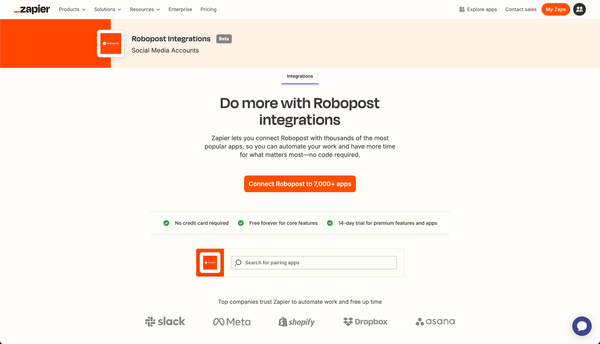The Role of Automation in Building Effective Social Media Campaigns
Explore how automation enhances social media campaigns for efficiency, consistency, and scalability. Unlock strategic advantages and best practices.

Automating social media tasks has become crucial for businesses looking to boost their online visibility and better connect with their audience. By using advanced technologies such as AI, companies can create personalized and dynamic social media campaigns, streamline their marketing activities, and ensure a consistent brand message across different platforms. This article explores how automation is used in social media campaigns, discussing its strategic benefits, practical uses, challenges, and best practices for achieving effective marketing outcomes.
Key Takeaways
- Social media automation saves time by handling routine tasks, allowing more focus on strategic planning and creative content creation.
- Automation advancements enable personalized and engaging campaigns, strengthening customer relationships and boosting brand engagement.
- Tools for automation help maintain consistency across platforms and scale social media efforts, which are vital for building trust and staying competitive.
- While automation provides many benefits, it's crucial to combine it with human interaction to preserve authenticity and forge genuine connections.
- Best practices for automation involve defining clear goals, choosing the right tools, and continuously assessing strategies to ensure they align with business goals.
Understanding Social Media Automation

Defining Social Media Automation
Social media automation involves using tools or software to handle repetitive tasks in social media marketing. These tasks include scheduling posts, generating analytics reports, and more, aimed at improving efficiency and enabling marketers to concentrate on strategic activities.
- Content curation
- Monitoring social media conversations
- Analyzing data and creating reports
- Engaging with and responding to followers
Knowing the breadth of automation is essential for implementing it effectively. It's not only about posting content but also about establishing a system that supports different facets of social media management, from discovering content to interacting with the audience.
Balancing Automation with Human Touch
Automation is a powerful tool that handles repetitive tasks, freeing up time for strategic planning and creativity for social media marketing. However, it's crucial to find a balance between automated processes and the authentic interactions that customers value. Personalized experiences and genuine connections are often best delivered through human interaction.
To achieve this balance, consider these steps:
- Regularly engage with your audience, ensuring quick and personalized responses to comments and messages.
- Keep your automation tools up to date by regularly reviewing and adapting them to stay current with social media trends and changes.
Strategic Advantages of Automation in Social Media
Enhancing Efficiency and Time Management
Automation speeds up routine tasks like scheduling posts and managing ad campaigns. This shift allows marketers to spend more time on strategic planning and creative work.
The benefits of automation are evident in how it eliminates manual tasks. For example, setting up a content calendar and automating posts significantly reduces daily social media workload. This organized approach improves workflow efficiency, freeing up professionals to focus on tasks requiring a personal touch, such as engaging with the audience or creating original content.
By using tools like Robopost, marketers not only manage time better but also spark innovation in their campaigns. The table below highlights how automation impacts time management in social media campaigns:
Task | Before Automation | After Automation |
|---|---|---|
Content Scheduling | Daily manual input | Automated weekly/monthly |
Ad Campaign Management | Frequent manual adjustments | Pre-set criteria and adjustments |
Audience Engagement | Constant monitoring | Alerts and triggers |
Embracing automation in social media isn't just about saving time; it's about reallocating that time to enhance campaign success and personal growth.
Achieving Consistency Across Platforms
Being consistent is crucial for establishing a recognizable brand identity. Automation tools play a vital role in ensuring that content is posted consistently across different platforms, maintaining uniform messaging and timing. By scheduling posts ahead of time, brands can keep a steady online presence, which is especially important for engaging a global audience across various time zones.
To stay competitive, it's important to continuously assess and update automation strategies based on platform changes and evolving user behaviors. Integrating real-time feedback mechanisms can further enhance automation, allowing brands to adjust content quickly and maintain a dynamic social media strategy.
Scaling Your Social Media Presence
Expanding your reach is essential for reaching a larger audience and making your brand's voice heard. Automation plays a crucial role in this expansion by efficiently managing multiple accounts across different platforms.
By using automation tools, marketers can ensure their brand remains active on platforms such as TikTok, Instagram, and Twitter, each with its own distinct demographics and user behaviors. This strategic presence across various social media platforms allows for a comprehensive approach to engaging with audiences.
- Efficiency: Automation handles routine tasks, freeing up time for strategic activities.
- Consistency: Maintains a consistent presence, which helps build trust in the brand.
- Scalability: Manages multiple accounts without requiring additional manpower.
Practical Applications of Social Media Automation
Automating Content Scheduling and Posting
Maintaining an active social media presence relies heavily on effectively scheduling posts. Automation tools like Robopost empower marketers to plan content well ahead of time, ensuring a steady and engaging online presence.
Social media automation tools typically include built-in calendars and scheduling recommendations. These features help visualize and adjust content strategies over time, ensuring a balanced mix of promotional, educational, and entertaining posts.
- Posting schedules
- Data analysis
Automating these tasks simplifies the process, freeing up valuable time for other strategic initiatives. It's essential to choose the right tools and fully leverage them to maximize the impact of your social media campaigns.
Real-time Engagement and Customer Service
Responding in real-time is crucial for effective customer service. Automation tools can be set up to instantly answer common questions, ensuring customers feel heard and valued, even outside regular business hours. This immediate interaction helps build a connection and can greatly improve the overall customer experience.
Using tools like chatbots and automated messaging services, brands can efficiently manage a large number of interactions. Here's how automation can streamline customer service on social media:
- Quickly acknowledge customer queries with automated responses.
- Schedule follow-up comments to maintain engagement after posting.
- Adjust content and outreach strategies in real-time based on analytics.
- Personalize experiences through optimized content and targeted communications.
Performance Tracking and Analytics
Tracking performance and analytics are crucial for understanding the success of marketing campaigns. Automated tools can monitor metrics like engagement rates, click-through rates, and conversion rates across various posts and platforms. This data not only helps assess specific strategies but also reveals insights into audience behavior and preferences, which can guide future campaigns.
Automation tools improve attribution capabilities by generating accurate reports that measure the direct impact of marketing efforts. Many tools offer pre-built reports that can be integrated into dashboards for a comprehensive overview. For example, an eCommerce business might track which products gain the most attention on social media to adjust promotional strategies accordingly.
To effectively measure the performance of your automated social media efforts, follow these steps:
- Gather essential data from your marketing campaigns.
- Monitor metrics such as sign-ups, audience engagement, and sales.
- Analyze the data to identify successful initiatives and areas needing improvement.
- Refine your marketing strategies based on these insights.
Challenges and Solutions in Social Media Automation

Maintaining Authenticity and Trust
Authenticity is essential for building trust and fostering engagement. While automation tools can be efficient, they sometimes create a gap that must be bridged with genuine human interactions. Brands can maintain a meaningful connection with their audience by personalizing content and ensuring it remains timely and relevant.
- Customize automated messages to reflect the brand’s tone and values.
- Interact with followers in real-time to cultivate a sense of community.
- Regularly update automation settings to align with current events and audience preferences.
While automation improves efficiency, it should never overshadow the human touch that is crucial for social media success. Finding the right balance ensures that your brand is viewed as both responsible and relatable.
Navigating the Pitfalls of Over-Automation
Relying too much on automation in social media can diminish the personal touch needed to form meaningful connections with your audience. Finding a balance between automated processes and human interaction is crucial to avoid the drawbacks of excessive automation. Here are some key steps to navigate these challenges:
- Personalization: Customize your automated messages for different audience segments to maintain engagement and avoid generic interactions.
- Authenticity: Ensure your brand's voice remains genuine and consistent, even when using automated tools.
- Relevance: Keep your content timely and contextually appropriate to stay connected with your audience.
By keeping these factors in mind, businesses can use automation to improve their social media campaigns while maintaining the quality of customer interactions.
Integrating Automation Tools with Human Oversight
Integrating automation tools with human oversight is crucial to maintaining the authenticity and effectiveness of social media campaigns. While automation handles repetitive tasks well, it's human input that brings creativity and empathy to campaigns. To strike the right balance, consider the following steps:
- Establish clear guidelines for when human intervention is necessary, especially in situations requiring thoughtful responses.
- Train team members to monitor automated processes and intervene when needed to deliver a personalized touch.
- Regularly review automated messages and update them to ensure they remain relevant and authentic.
By implementing these steps, businesses can ensure that their social media automation not only runs efficiently but also connects with their audience on a personal level. The goal is to provide a seamless customer experience that resonates with customers while maintaining the human touch they value.
Best Practices for Effective Social Media Automation
Setting Clear Goals and KPIs
Before you start using social media automation, it's important to clearly define your goals and objectives. These goals should align with your overall marketing strategy and guide you in choosing the right automation tools.
To ensure your social media campaigns are effective, establish key performance indicators (KPIs) that align with your goals. For instance, if you want to increase engagement, track metrics like likes, comments, and shares. If your focus is on driving sales, monitor conversion rates and return on investment (ROI).
When setting these benchmarks, consider the following factors:
- The specific results you want to achieve
- The timeline for achieving these results
- The tools and resources you have available
- The methods you'll use to measure success
Choosing the Right Automation Tools
When choosing automation tools for your social media campaigns, it's crucial to find ones that not only match your business goals but also suit your target audience and fit well with your content strategy.
As you compare options, look at the specific features each tool offers. Some tools may focus on advanced analytics, while others excel in recycling content or scheduling posts based on specific conditions. For example, FeedHive is known for its effective content recycling capabilities, which can significantly boost your social media efficiency.
Regularly Reviewing and Adjusting Strategies
Regularly reviewing and adjusting strategies is crucial for maintaining long-term success. This continuous process ensures that your campaigns remain relevant and effective, especially as platform algorithms and user behaviors evolve.
It's also important to keep up with the latest platform updates and best practices. Social media platforms frequently change their algorithms, which can significantly impact how your automation strategies perform. To keep your campaigns effective, adapt to these changes. For example, testing new features as they are released can give you a competitive advantage and improve interaction with users.
Lastly, evaluate the effectiveness of your automation tools by analyzing performance data. Use insights from analytics to refine your approach, ensuring that each campaign is optimized to reach and engage your audience effectively.
Conclusion
Automation has become essential for creating effective social media campaigns. It provides efficiency, consistency, and scalability, enabling businesses to concentrate on strategic growth while maintaining a robust online presence. AI-powered personalization enhances audience engagement and builds stronger customer relationships. However, it's crucial to balance automation with genuine human interaction to preserve the personal touch that's crucial in social media. As we look ahead in social media marketing, automation will undoubtedly continue shaping the landscape, fostering innovation, and helping businesses reach their audiences more effectively than ever.
